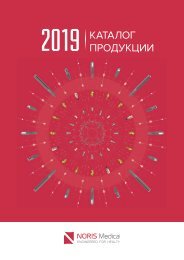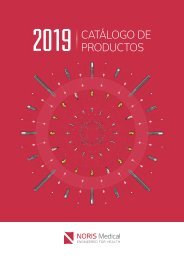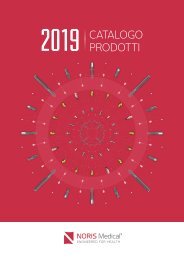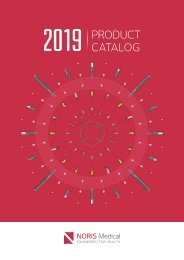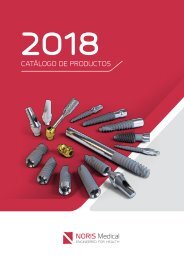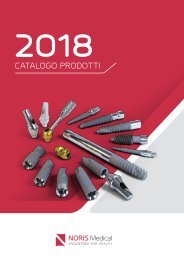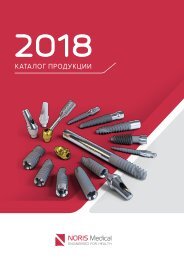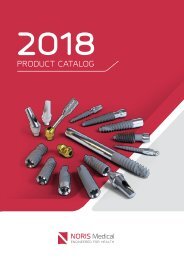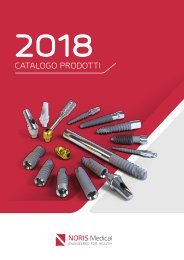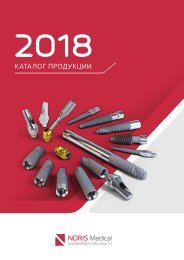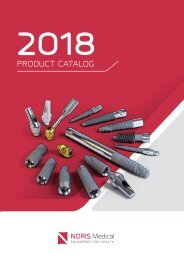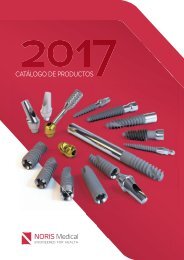Zygomatic Implants - Noris Medical
Create successful ePaper yourself
Turn your PDF publications into a flip-book with our unique Google optimized e-Paper software.
<strong>Zygomatic</strong> <strong>Implants</strong><br />
for the Extra Maxillary Approach
Table of Contents<br />
Indications for Use 3<br />
The Extramaxillary Approach 4<br />
<strong>Zygomatic</strong> Implant 5<br />
Drill Sequence 6-7<br />
Multi-Unit Components 8-10<br />
Clinical Case 11-18
<strong>Zygomatic</strong> Implant - Indications for Use<br />
The <strong>Zygomatic</strong> implant placement is a highly predictable<br />
procedure with a high success rate in restoration of atrophic jaws,<br />
without the need for complex bone augmentation procedures.
<strong>Zygomatic</strong> Implant - Extramaxillary Approach<br />
• <strong>Noris</strong> <strong>Medical</strong> <strong>Zygomatic</strong> implant is placed following the<br />
extramaxillary protocol; this is a modification of the traditional<br />
Branemark technique.<br />
• In the Extramaxillary approach a bypass of the maxillary<br />
sinus is being made in a manner that prevents damage to<br />
the sinus membrane.<br />
• The <strong>Zygomatic</strong> implant is anchored in the zygomatic bone;<br />
the resulting torque is very high.<br />
• The implant prosthetic platform is being shifted buccally to a more<br />
appropriate position of the restoration.<br />
• The design of <strong>Noris</strong> <strong>Medical</strong> <strong>Zygomatic</strong> implant is an unthreaded<br />
body ending with an aggressive thread at the apical part of<br />
the implant.<br />
• A special drill design allows the clinician to create a clean tunnel<br />
preparation with minimal risk of membrane damage.<br />
• A 45° angle Multi-Unit abutment will provide the angle<br />
correction needed.<br />
/ 4 / <strong>Zygomatic</strong> <strong>Implants</strong>
<strong>Zygomatic</strong> Implant<br />
0 D (mm) 0 D1 (mm) L (mm) Item<br />
35 NM-F4435<br />
37.5 NM-F4437<br />
40 NM-F4440<br />
42.5 NM-F4442<br />
4.2 3.5<br />
45 NM-F4445<br />
47.5 NM-F4447<br />
50 NM-F4450<br />
52.5 NM-F4452<br />
55 NM-F4455<br />
57.5 NM-F4457<br />
Cover Screw Included with all implants<br />
NM-S5023<br />
• Especially designed for the extramaxillary approach<br />
• Available in lengths from 35mm to 57.5mm with 2.5mm increments<br />
• 2.43mm internal hex. connection<br />
• Smooth body to reduce periopathogens adherence<br />
• Deep threads for excellent stability in the zygomatic bone<br />
• RBM treated surface at the threaded part, increases the BIC
Tools<br />
<strong>Zygomatic</strong> Step Drills<br />
0 D (mm) L (mm) Drill No. Item<br />
2.0<br />
75<br />
NM-D7020<br />
1<br />
95 NM-D7120<br />
2.8<br />
75<br />
NM-D7028<br />
2<br />
95 NM-D7128<br />
3.2<br />
75<br />
NM-D7032<br />
3<br />
95 NM-D7132<br />
<strong>Zygomatic</strong> Burs for groove preparation<br />
0 D (mm) L (mm) Item<br />
Fine Grit<br />
NM-D7201<br />
4.2 30<br />
Medium Grit<br />
NM-D7202<br />
Coarse Grit<br />
NM-D7203<br />
/ 6 / <strong>Zygomatic</strong> <strong>Implants</strong>
60<br />
55<br />
50<br />
45<br />
40<br />
35<br />
Drill Sequence<br />
60<br />
55<br />
50<br />
45<br />
40<br />
35<br />
1<br />
60<br />
55<br />
50<br />
45<br />
40<br />
35<br />
2<br />
60<br />
55<br />
50<br />
45<br />
40<br />
35<br />
3<br />
60<br />
55<br />
50<br />
45<br />
40<br />
35<br />
3<br />
16<br />
ø2.8<br />
ø2.8<br />
ø2.8<br />
ø2<br />
ø3.2<br />
ø3.2<br />
ø3<br />
ø3<br />
ø2.5<br />
ø4.2<br />
ø4.2<br />
ø4.2<br />
ø4.2<br />
D4 D3 D2 D1<br />
Bone<br />
Type<br />
8<br />
4<br />
0
Multi-Unit Components<br />
Straight<br />
L (mm)<br />
Angulated 17 0 Angulated 30 0 Angulated 45 0 L (mm)<br />
NM-A7101<br />
1<br />
NM-A7112 - -<br />
2<br />
NM-A7102<br />
2<br />
NM-A7113 NM-A7133 -<br />
3<br />
NM-A7103<br />
3<br />
- NM-A7134 NM-A7144<br />
4<br />
Included with<br />
all multi-unit<br />
bases<br />
Included with<br />
all multi-unit bases<br />
NM-X7100<br />
NM-S7101<br />
NM-X7101<br />
Recommendation: Tighten the base<br />
at a torque of 25 Ncm.<br />
Recommendation: Tighten the screw at a torque of 20 Ncm.<br />
/ 8 / <strong>Zygomatic</strong> <strong>Implants</strong>
Healing Cap<br />
Transfers & Analog<br />
Abutments<br />
Screw<br />
Screw<br />
L 13mm<br />
Screw*<br />
NM-S7102<br />
Healing Cap<br />
Ø 4.8mm H 4.3mm<br />
NM-S7111<br />
Open Tray<br />
Ø 4.8mm H 11mm<br />
NM-S7102<br />
Universal Abutment<br />
Ø 4.8mm H 12mm<br />
NM-H7101<br />
NM-T7111<br />
NM-T7121<br />
Star Hex. Drivers<br />
Short Driver<br />
1.25mm L 7mm<br />
NM-X7006<br />
Long Driver<br />
1.25mm L 14mm<br />
NM-X7007<br />
Straight Multi-Unit Drivers<br />
Short Driver<br />
2.0mm L 6mm<br />
2mm<br />
Plastic Cap<br />
Ø 4.8mm H 11mm<br />
NM-T4402<br />
Screw<br />
NM-S7102<br />
Closed Tray<br />
Ø 4.8mm H 8mm<br />
NM-T7102<br />
Screw*<br />
NM-S7102<br />
Castable Abutment<br />
Ø 4.8mm H 12mm<br />
NM-C7121<br />
* Recommendation: Tighten the screw at<br />
a torque of 15 Ncm.<br />
NM-X1016<br />
Long Driver<br />
2.0mm L 10mm<br />
Analog<br />
Ø 4.8mm<br />
NM-T7151<br />
NM-X1017<br />
Short Motor Mount<br />
2.0mm L 20mm<br />
NM-X1120<br />
Long Motor Mount<br />
2.0mm L 25mm<br />
NM-X1125
Passive Fit Castable Abutment Kit<br />
Screw*<br />
NM-S7102<br />
Universal Abutment<br />
Ø 4.8mm H 12mm<br />
NM-T7121<br />
Castable Sleeve<br />
Ø 4.8mm H 10.5mm<br />
The Passive Fit Castable Abutment Kit consists<br />
of three parts aimed for the fabrications of<br />
accurate metal reinforced prostheses.<br />
The Castable Sleeve Positioner is used<br />
for locating the Castable Sleeve on the<br />
plaster model, ensuring passive fit of the<br />
fabricated metal cast when cemented to the<br />
Titanium Abutments.<br />
NM-C7120<br />
* Recommendation: Tighten the screw at a torque of 15 Ncm.<br />
Castable Sleeve Positioner<br />
Ø 4.8mm H 10mm<br />
NM-T7122<br />
/ 10 / <strong>Zygomatic</strong> <strong>Implants</strong>
Clinical Case<br />
Prosthetic Rehabilitation of Atropic Maxilla<br />
Using 4 <strong>Zygomatic</strong> <strong>Implants</strong><br />
Prosthetic rehabilitation of the upper jaw, after major bone resorption, is very challenging from<br />
both surgical and prosthetic points of view. The absence of teeth leads to cessation of the<br />
stimulation of the alveolar bone. The stimulation is caused by the physiological load which is<br />
transferred to the alveolar bone and prevents resorption.<br />
Shortly after the teeth extraction the process of alveolar bone resorption starts. The ongoing<br />
resorption is progressively continuing over the years until reaching atrophy. Installation of dental<br />
implants at this stage, using conventional techniques, is very difficult due to extensive bone<br />
resorption and the accompanied pneumatization of the maxillary sinuses.<br />
The conventional treatment options for these patients are mostly augmentation procedures, which<br />
are meant to increase the volume of the load bearing bone.<br />
The bone for the augmentation is taken from different sources, such as: the iliac crest, or intraoral<br />
origin, like the mandibular ramus, the intermental region etc. Augmentation procedures are very<br />
complicated and require a long recovery period.<br />
An additional treatment option for atrophic maxilla is the placement of <strong>Zygomatic</strong> implants.<br />
The <strong>Zygomatic</strong> bone was found to be suitable for installation of dental implants. In 1998<br />
Branemark presented the <strong>Zygomatic</strong> implant as an optional solution for the treatment of oncologic<br />
patients. This solution was expanded later on to Atrophic Maxilla. Long implants were found to be<br />
a good alternative for complicated augmentations procedures. Even though they are not easy to<br />
install, they present promising outcomes (1, 2, 3).<br />
<strong>Noris</strong> <strong>Medical</strong> <strong>Zygomatic</strong> Implant was especially designed for implantation in the Extramaxillary<br />
approach. The Extramaxillary approach enables the positioning of the prosthetic connection<br />
on the Alveolar Ridge, unlike the other methods in which the prosthetic unit is more palatinially<br />
positioned (4). This location is more correct and easier for the rehabilitation process.<br />
In the Extramaxillary approach, the implant’s stability is being achieved only by the <strong>Zygomatic</strong><br />
bone. For this reason the implant is designed with a spiral and deep retentive thread shape at its<br />
apex, while the rest of the implant is smooth. The diameter of all the <strong>Zygomatic</strong> <strong>Implants</strong> is 4.2mm<br />
and their lengths vary between 35mm and 57.5mm.
Case Description<br />
68 years old female patient<br />
<strong>Medical</strong> history:<br />
• Controlled high blood pressure;<br />
• Balanced Type II diabetes;<br />
• Bilateral mastectomy in 2008;<br />
Clinical and radiological findings:<br />
Combination Syndrome;<br />
Pneumatization of the Maxillary Sinuses;<br />
Severe resorption of the upper alveolar ridge;<br />
Perimplantitis and mucositis around implant in position of tooth 31.<br />
Treatment Plan<br />
After radiological and CT assessments it was decided to install two Tubero Pterygoid<br />
Palatine <strong>Implants</strong>, 4 <strong>Zygomatic</strong> implants at the Extramaxillary approach and one implant<br />
in the incisive canal.<br />
The surgical procedure was done in the Split Mouth technique, in order to reduce the<br />
exposure time of the bone.<br />
After the installation of the implants, augmentation was done, using Calcium<br />
Sulfate + HA.<br />
Correction of angulation was achieved by using Multi-Units in angulation of 17, 30, 45<br />
degrees as found necessary.<br />
In the lower jaw, the removable prosthesis was changed to fixed prosthesis, on Multi-Unit<br />
bases, as well. Rehabilitation was performed on the day of the surgical procedure.<br />
A few hours after the operation, the patient received two provisional acrylic bridges<br />
reinforced by induction welded Titanium (grade 5) bar.<br />
/ 12 / <strong>Zygomatic</strong> <strong>Implants</strong>
1<br />
Panoramic and CT illustrate the Pneumatization of the Maxillary Sinuses and the Severe<br />
resorption of the upper Alveolar Ridge (Figs 1, 2).<br />
2<br />
3<br />
Combination Syndrome.
Upper Jaw<br />
4<br />
Groove preparation for leading the <strong>Zygomatic</strong><br />
Implant drill.<br />
5<br />
The integrity of the Schneiderian Membrane can be<br />
observed (Figs 5, 6).<br />
6<br />
7<br />
<strong>Zygomatic</strong> Implant in situ.<br />
/ 14 / <strong>Zygomatic</strong> <strong>Implants</strong>
8<br />
Correcting the Angulation using a 45°<br />
Multi-Unit Abutment.<br />
9<br />
The surgical procedure was done by Split Mouth<br />
technique in order to reduce the exposure time of the<br />
bone during the installation of the <strong>Zygomatic</strong> <strong>Implants</strong>.<br />
Two <strong>Implants</strong> were placed on each side (Figs 9. 10).<br />
10<br />
11<br />
After the installation of the implants, augmentation was<br />
done using Calcium Sulfate + HA.
12 13<br />
Transfers were mounted and fixed on the Multi-Units in order to take an impression using the Open Tray technique<br />
but the impression was taken without using a tray (Figs 12, 13, 14).<br />
14 15<br />
Impressions of the lower jaw, using Snap-On Transfers<br />
Upper jaw provisional Acrylic Bridge reinforced by<br />
induction welded Titanium (grade 5) bar.<br />
16 17<br />
/ 16 / <strong>Zygomatic</strong> <strong>Implants</strong>
18 19<br />
20 21<br />
22 23<br />
Lower jaw provisional acrylic bridge reinforced by<br />
induction welded Titanium (grade 5) bar.<br />
In the upper jaw Two Tubero Pterygoid Palatine <strong>Implants</strong>,<br />
four <strong>Zygomatic</strong> implants at the Extramaxillary approach<br />
and one implant in the incisive canal were installed.
References:<br />
1. Boyes-Varley JG, Howes DG, Davidge-Pitts KD, Brånemark I, McAlpine JA. A protocol for maxillary<br />
reconstruction following oncology resection using zygomatic implants. Int J Prosthodont. 2007<br />
Sep-Oct;20:521-31.<br />
2. D'Agostino A, Procacci P, Ferrari F, Trevisiol L, Nocini PF. Zygoma implant-supported prosthetic<br />
rehabilitation of a patient after subtotal bilateral maxillectomy. J Craniofac Surg. 2013<br />
Mar;24(2):e159-62.<br />
3. Maló P, Nobre Mde A, Lopes I. A new approach to rehabilitate the severely atrophic maxilla using<br />
extramaxillary anchored implants in immediate function: a pilot study. J Prosthet Dent. 2008<br />
Nov;100(5):354-66.<br />
4. Aparicio C, Ouazzani W, Hatano N. The use of zygomatic implants for prosthetic rehabilitation<br />
of the severely resorbed maxilla. Periodontol 2000. 2008;47:162-71.<br />
/ 18 / <strong>Zygomatic</strong> <strong>Implants</strong>
Notes
ZygBro. 2015 Rev.2 EN<br />
www.norismedical.com



